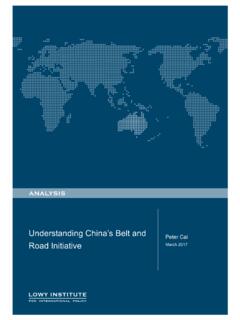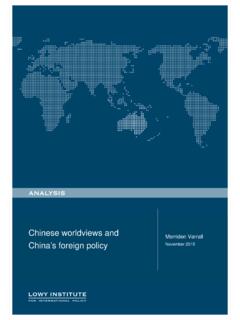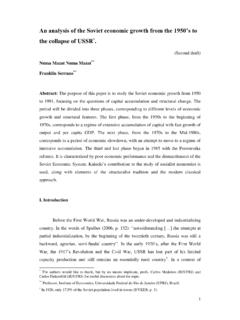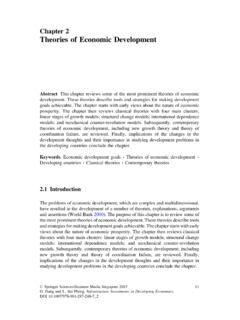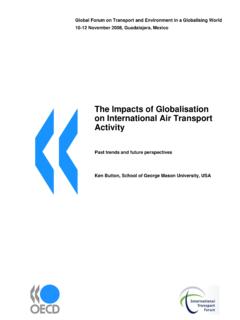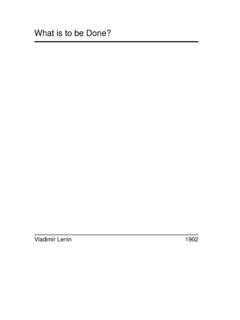Transcription of India’s new Asia-Pacific strategy: Modi acts East
1 India s new Asia-Pacific strategy: Modi acts East Danielle Rajendram December 2014 INDIA S NEW Asia-Pacific STRATEGY: MODI ACTS EAST The Lowy Institute for International Policy is an independent policy think tank. Its mandate ranges across all the dimensions of international policy debate in Australia economic , political and strategic and it is not limited to a particular geographic region. Its two core tasks are to: produce distinctive research and fresh policy options for Australia s international policy and to contribute to the wider international debate.
2 Promote discussion of Australia s role in the world by providing an accessible and high-quality forum for discussion of Australian international relations through debates, seminars, lectures, dialogues and conferences. Lowy Institute Analyses are short papers analysing recent internationaltrends and events and their policy implications. The views expressed in this paper are entirely the author s own andnot those of the Lowy Institute for International Policy. INDIA S NEW Asia-Pacific STRATEGY: MODI ACTS EAST 1 EXECUTIVE SUMMARY The Look East policy has been a major part of India s international engagement since its economic opening in 1991.
3 Having received bipartisan support from successive Indian governments, the policy has evolved from economic and diplomatic engagement with Southeast Asia to broader security and defence ties across the whole Asia-Pacific . In recent years, India has signalled a willingness to play a greater strategic role in the region, deepening links with such partners as Japan, Vietnam, and Australia. The policy has been driven in part by India s strategy of external balancing against China, but has also been motivated by India s desire for a greater global role and its rise as a trading nation.
4 Narendra Modi s landslide victory in the May 2014 election provides the chance to build on this momentum to carve out a greater strategic role for India in the Asia-Pacific . China s expanding presence in the Indian Ocean and assertiveness in maritime territorial disputes in East Asia has reinforced the relevance of an enhanced Indian role in East and Southeast Asia for India and its Asia-Pacific partners. Already Modi has indicated his intention to transform the Look East policy to Act East . Although the Modi Government has expressed its intention to focus initially on relations with India s South Asian neighbours, its commitment to pursue economic growth and a more ambitious foreign policy will lead to an increased eastward focus.
5 INDIA S NEW Asia-Pacific STRATEGY: MODI ACTS EAST 2 The Look East policy has shaped India s engagement with the Asia-Pacific for over two decades, substantially deepening India s economic , institutional, and security relations with the region. Initially intended to develop India s economic ties with Southeast Asia, India s engagement with its eastern neighbours has since shifted to include Northeast Asia and Australia. In recent years, Look East has acquired a strategic dimension with a significant naval emphasis.
6 Elected with the largest electoral mandate in over 30 years, the government of Narendra Modi has an exceptional opportunity to transform India into a serious strategic player in East and Southeast Asia. While early foreign policy decision-making pointed to a prioritisation of relations within South Asia, the Modi Government has since demonstrated its intention to pursue a more ambitious foreign policy agenda, including carving out a greater global role for India. Early interactions with East and Southeast Asia have been positive, and partnerships with Japan, Vietnam, Australia, ASEAN, and Indonesia hold particular promise.
7 Should the regional situation in South Asia remain reasonably stable, it can be expected that India under Modi will pursue a greater role in East and Southeast Asia in line with its growing economic and strategic interests. This Analysis will examine the future of India s relations with East and Southeast Asia under the Modi Government. It first outlines the origins and evolution of the Look East Policy under previous governments, and illustrates the centrality of Look East to Indian foreign policy. Second, it examines the Modi Government s early foreign policy decision-making, and assesses its probable impact on the development of India s Asia-Pacific strategy.
8 It then identifies key relationships in the Asia-Pacific and looks at their likely evolution under the Modi Government. Finally, it analyses the external and internal factors that have the potential to accelerate or diminish India s emphasis on engagement with the Asia-Pacific . LOOK EAST India s Look East policy was initiated under the Narasimha Rao Government in the early 1990s amid a worsening domestic economic and political situation. The geopolitical tensions leading up to the 1991 Gulf War deeply affected India s economy, bringing about economic recession and an acute balance-of-payments crisis by This crisis drove India to search for economic opportunities in more dynamic parts of Asia.
9 In addition, the Look East policy was driven by three specific factors. The collapse of the soviet Union created a strategic and economic vacuum for India, and the end of Cold War bipolarity reduced the relevance of India s non-aligned stance. Second, China s opening ..Narendra Modi has an exceptional opportunity to transform India into a serious strategic INDIA S NEW Asia-Pacific STRATEGY: MODI ACTS EAST 3 just over a decade earlier prompted India to reach out to Southeast Asia to avoid falling into a subordinate political and economic role in the region.
10 India was also driven by a desire to develop and stabilise its fragile Northeastern states, which were in the midst of insurgency. As four of the Northeastern states share a 1643km long land border with Myanmar, they are critical to overland connectivity with Southeast These factors, combined with the Gulf Crisis, put the need to diversify India s energy sources and economic partnerships into sharp focus. India needed to integrate into the global economy, and the dynamism of India s eastern neighbours made Southeast Asia an attractive place to start.
